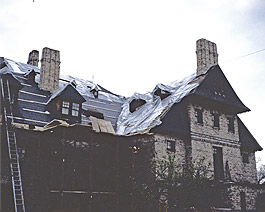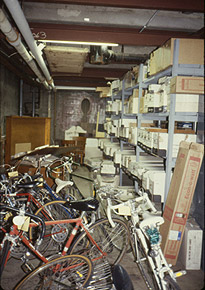
general building issues
|
|
The design of your building has a significant effect on the preservation of the collections stored within. The indoor environment is affected by the type and extent of insulation, the presence of windows, the capacity of the structure to resist moisture, and the presence of chemicals and/or pollutants generated by interior finishes and furnishings. In addition, the layout of storage and workspaces affects the maintenance of the climate, and security considerations.
Routine inspection and maintenance of the building and its systems are part of a comprehensive preservation program. Upkeep of the building reduces the possible impacts of weather, forestalls water damage, and ensures that building systems are working properly.
If your institution is constructing a new facility, or renovating an existing site, preservation concerns should be taken into account when considering new designs for collection storage and use. This is true for both our main building and for any offsite structures. If you are not rebuilding or renovating, there are many options for improving existing structures to ensure the best possible protection for your collections.
1 Building Design
The following are some of the most important preservation issues to consider when designing a new building or making changes to an existing structure.
Layout
Maintaining separate collection storage spaces from usage areas, like a reading room, enhances security and allows for more specific climate control. It is best to store collections in an internal space without windows or other exposure to the outside environment. Collections storage areas should be keyed separately from other rooms. When possible, consolidate collections storage into a single closed area, to improve security and make environmental controls more efficient. Additionally, the layout of circulation, reference, and reading spaces must consider the need for supervision of patrons.
Water Control
|
Storing collections in basements is not |
Basement-level storage areas are undesirable, due to their tendency toward flooding and moisture. If basement storage is unavoidable, the floor and exterior walls should be well-sealed, and collections should be isolated from basement-level mechanical equipment. With the exception of fire suppression pipes, water-bearing pipes should not run through collections storage spaces. All shelving should provide 4" floor clearance. Shelving should not be placed against exterior walls, as this can lead to condensation and other problems. Cooling towers, lavatories, kitchens, janitor's spaces, and other water-carrying equipment should never be located above collections storage (including technical services, or any other areas where collections are stored for extended periods).
See Session 8: Emergency Preparedness for more information on water hazards and a Water Damage Checklist.
Insulation and Vapor Barriers
Good insulation will reduce the effect of outdoor environmental conditions on indoor conditions. If there are windows, they should be properly insulated (e.g., double-paned). Consistent use of shutters, blinds, or curtains will reduce heating from sunlight. The use of vapor barriers is also important in controlling humidity within the building. Older buildings are often sturdily constructed of hygroscopic materials (e.g., wood, plaster, brick) that absorb and release moisture, while newer buildings have thinner walls and more easily allow moisture to pass through to the interior. Vapor barriers include various floor and wall coverings, such as waterproof paint or polyethylene film.
Systems
Fire protection, security systems, and climate control equipment are crucial to preservation planning, and should be included in the management of existing or newly-constructed buildings. Because of the importance of these topics, these systems are addressed in further detail later in this session.
Floors and Walls
Carpeting should be avoided in collection storage spaces, as it can off-gas pollutants and absorb moisture easily. If storage areas are to be painted with collections in place, use only vinyl, acrylic, or latex paints. If areas must be painted using other types of paints, be sure to allow enough time for vapors to dissipate before returning collections to the area. Dropped ceilings are also not recommended, since they make it harder to identify leaks and can hide mold growth.
2 Building Maintenance
Particularly in large institutions, facilities personnel are likely to have many responsibilities and pressures, including the need to save money and conserve energy. Some of these concerns may conflict with preservation needs and best practices. Facilities personnel frequently hear complaints about staff comfort (e.g. too hot or too cold), which may overshadow considerations for the collection environment.
Developing a good working relationship with your facilities personnel will benefit you and your collections. You can rely on your facilities staff to collect environmental data, maintainence histories, and understand your building systems better. Be sure that you understand the limitations of your building and equipment, so that you do not make unrealistic requests and changes.
3 Offsite storage
Offsite storage is fairly common in libraries and archives, due to the size of collections, and the fact that some collections must be retained but are not frequently accessed. Offsite storage may also be used to store collections temporarily, such as during building renovation, or in the aftermath of a disaster.
Offsite storage facilities, even temporary ones, should meet the same preservation standards as in a main building. Exposure to a poor or uncontrolled environment can significantly shorten the life expectancy of collections, even if it is only for a short time.
When preparing offsite storage, staff should pursue the same protection against fire, theft, and other security concerns, as an institution's central location. Spaces should be inspected and approved before any contracts are signed or materials are moved. Once a space is selected, staff should visit the collections periodically (once a week or more, depending on the location), to ensure that conditions remain acceptable. Alternatively, dataloggers or other environmental monitoring equipment may be used to read and report on the collections climate.

 Routine building and roof inspections should be planned to identify and prevent issues before they develop into problems.
Routine building and roof inspections should be planned to identify and prevent issues before they develop into problems.